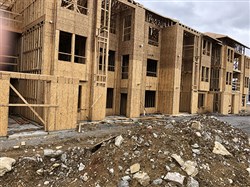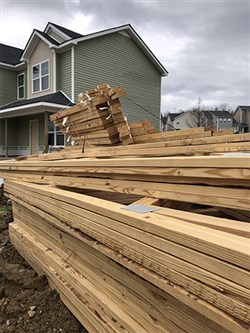VOL. 45 | NO. 13 | Friday, March 26, 2021
Building boom’s dark cloud
By Kathy Carlson
One year into the coronavirus pandemic, Nashville builders and homeowners are holding on to the bucking bronco that is the construction industry.
Prices for some much-used wood products have doubled and even tripled over the past year. Lead times for windows, appliances and more have stretched into weeks and months. Prices of other materials are rising or in short supply as well, and mortgage rates have been edging up.
Despite all the economic uncertainty and early-2020 job losses, people from bigger cities keep moving here, and construction businesses are scrambling to keep up. Builders are keeping their fingers crossed for a breather from rising materials prices as they take steps to adjust.
“COVID put out a lot of challenges,” says Trey Lewis, vice president for sales with Ole South Properties, a large privately owned homebuilder based in Murfreesboro. “It changed the way we buy and sell.
“COVID has redefined our homes. It is not only where we live, it may be where we work, where we go to school, where we gather,” he adds. “People are spending more time than ever at home, and that won’t be changing any time soon.”
Despite the challenges of COVID, he and others say last year set records for many builders. Material prices may have gone up, but interest rates declined during that period and helped subsidize the net cost of ownership by effectively holding down monthly mortgage payments, Lewis adds.
“Right now, residential real estate is in a not-so-perfect storm” of rising prices, rising interest rates, rising energy costs, and decreasing numbers of available homes, he continues. The industry will eventually find out how much longer the average homebuyer’s income can absorb these factors.
That said, the supply of housing in the Midstate still has not caught up with demand.
“The supply of new homes is very tight, and the demand is very real,” he says.
Builder David Luecke, president of Capitol Homes Inc., has worked through the Sept. 11 attacks, the Great Recession of 2008-09 and, now, the COVID-19 pandemic.
Capitol Homes did well in 2020, despite the pandemic’s turmoil, he says.
“My guess is that 2021 is going to be the most challenging year ever experienced” in residential construction, he adds. But it won’t be challenging in the same way as the Great Recession.
“In 2008, we had a large amount of inventory coupled with owners who were not going to make their mortgage payments causing an increase in inventories because of foreclosures,” he says, adding that led to a bubble and a massive price drop for homes.
“I don’t think pricing will suffer (in 2021), but the number of homes to be built might decline because (of) purchasers’ sticker shock at new prices,” Luecke says.
This time around, local builders, remodelers and others are finding it much harder, if not impossible, to estimate what their costs are going to be and how long a job will take.
Luecke says big, publicly traded residential construction companies generally report a net margin on revenue of about 6%-7% in a good year, based on selling homes that cost $400,000 on average.
If, for example, a builder had a contract to build a $400,000 home, the company might have budgeted for lumber costs of about $30,000. A 6% net margin would be about $24,000.
But if the price of lumber rose by more than $24,000 between the signing of the contract and actually building the house, the house wouldn’t be profitable, all other things being equal, he explains.
Other problems? Local builders and others say:
• It’s taking longer for builders to obtain permits from local governments
• There are longer lead times for obtaining a host of materials
• Some suppliers have shortened the time for which they’ll guarantee a price.
All of that makes it harder to estimate job costs.
Prices for some lumber products have risen sharply. Oriented strand board is used for wall sheathing, subflooring and other parts of a house. It’s sold in 4-foot by 8-foot sheets that cost about $10 a year ago. It now can go $30.
Wood shows up throughout a house, in cabinetry, doors, windows, hardwood floors and more, and wood prices in general have risen.
Material costs can change on a daily basis, Lewis says, and there’s a point at which a builder will halt construction due to unfavorable pricing or material availability.

High costs are taking its toll on prospective homebuyers, but it’s also driving up the expense of other construction, including this apartment complex at Hobson and Murfreesboro roads in Antioch.
-- Photos By Lyle Graves |The LedgerLarger builders have signed presale contracts with customers, with the builder committing to build a specified house for a certain price and the customer committing to buy it. The contracts give potential lenders assurance that the builder can pay back any construction loan because houses under contract are presold.
With volatile material costs, Luecke adds, builders start to ask themselves, “How do I write a contract when lumber prices can rise 10% in a week?”
Capitol Homes stopped writing presale contracts in December, Luecke notes.
Ole South will not write a purchase contract until a firm delivery date with firm pricing can be given, Lewis says. The company now sets up waiting lists for homes under construction.
“While we continue to be optimistic about new home sales,” he continues, “we do anticipate costs to continue to rise for the immediate future.”
Others in residential construction – notably custom builders and remodelers – generally operate under cost-plus contracts, which can provide protection from rapidly escalating material costs. Companies still need to provide timely work and they’re taking steps to make sure jobs are done on time.
Lead time on supplies is another problem, says Will Forte, owner, founder and project manager of Brentwood-based Forte Building Group, a small, family owned custom construction and remodeling company.
“We haven’t even started construction yet but are needing to sign off and get a decision on windows and doors,’’ Forte says. They won’t be needed until well into the project, but the lead time for windows is anywhere from 10-12 weeks, so they need to be chosen and ordered now. The normal lead time is four weeks.
It’s not just wood products. Light fixtures and tile, for example, used to be available within two to four weeks. It now takes eight to 10 weeks.
“It really complicates things,” Forte says. Homeowners, eager to have projects completed, are adjusting to the new, earlier deadlines.
Another small, family owned business, Broderick Builders Inc., has been remodeling homes in Nashville for 35 years. Broderick handles everything from decks and screened porches to home additions, all lumber-intensive jobs.
Company President Jason Broderick has seen the price of an 8-foot two-by-four climb from $3.50 two years ago to $10, and that was six months ago. The price for OSB and pressure-treated lumber also has risen.
“Everyone wanted to do a deck and a fence last year,” he says. That bid up the price of pressure-treated wood.

The COVID-19 pandemic is impacting Ole South’s The Preserve at Old Hickory project in the way its units are designed and in the difficulty it is having with rising material prices and availability.
As demand rose last year, supply also fell because lumber processors were having to schedule fewer employees and have them work farther apart – socially distanced – to help curb the spread of COVID-19.
“All the manufacturers had to cut down their workforce to a third of what it was” at a time of high demand, Broderick says.
The same thing was happening in factories making other, non-lumber building supplies. Record cold weather, ice storms and power outages halted building-supply production in Texas and elsewhere. Demand for products also rose earlier in 2020 when folks staying at home during the pandemic decided to tackle home-improvement projects. And Trump-era tariffs on building products such as Canadian lumber also ratcheted up prices.
Nonprofits that help with housing needs also feel the pinch.
Rebuilding Together Nashville helps vulnerable, lower-income Nashvillians stay in their homes by helping them make needed home repairs. Director of Programs Andrea Prince says she has seen OSB prices skyrocket, and recently it took seven weeks for a window to come in on one recent project. Outreach Coordinator Jarod Hamm has seen longer-than-usual wait times for appliances such as washers and dryers.
Prince says the nonprofit is coping by seeking additional grants and resources.
Hamm points out price increases and short supplies for materials may continue for another year, but he’s hopeful that will abate. Once more people are vaccinated against COVID-19, he says, factories will be able to increase production, reducing wait times and, he hopes, lowering prices.
“We hope that with getting more of a grip on the pandemic that we may see pricing come down this year,” says Adam Forte, son of Will Forte and an owner-project manager in the business. “Basically, we’re hoping that some of these (price increases) will level off this year or (go) back down.”
Broderick adds he has seen materials prices come down a little in the past three or four months, and he hopes that will continue. He doesn’t see prices dropping to pre-pandemic levels, though.
Meanwhile, the pandemic and construction continue. People keep moving to Nashville. Many of the newcomers are 40 to 60 years old; they’re often established residents of places like California, New Jersey, Washington state, Adam Forte says.
Many are looking for “a good amount of land” in places like Franklin, Leiper’s Fork, Ashland City. Customers “may have shifted a little more to remodeling” instead of building a new home, he notes.
Broderick, bullish on remodeling, says business is “just as busy as can be (and I) don’t see any slowing down any time soon.”
And, he adds, “The Amazon people haven’t even moved here yet.”